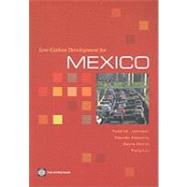
Note: Supplemental materials are not guaranteed with Rental or Used book purchases.
Purchase Benefits
Looking to rent a book? Rent Low-Carbon Development for Mexico [ISBN: 9780821381229] for the semester, quarter, and short term or search our site for other textbooks by Johnson, Todd M.; Alatorre, Claudio; Romo, Zayra; Liu, Feng. Renting a textbook can save you up to 90% from the cost of buying.
| Preface | p. ix |
| About the Authors | p. xiii |
| Acknowledgments | p. xv |
| Abbreviations | p. xvii |
| Overview | p. 1 |
| Benefit of Moving to a Low-Carbon Economy | p. 1 |
| Mitigation Options, by Sector | p. 2 |
| Emissions Reductions Associated with a Low-Carbon Scenario | p. 6 |
| Elements of a Low-Carbon Program | p. 7 |
| Introduction | p. 11 |
| Objective of the Study | p. 11 |
| Strategic Significance to Mexico of Low-Carbon Development | p. 13 |
| Greenhouse Gas Emission in Mexico | p. 15 |
| Mexico's Climate Change Actions | p. 17 |
| Overview of the Sector Analysis and Structure of the Report | p. 18 |
| Electric Power | p. 23 |
| The Baseline Scenario | p. 25 |
| The MEDEC Low-Carbon Scenario | p. 27 |
| Barriers to Mitigating Greenhouse Gas Emissions | p. 30 |
| Conclusions | p. 31 |
| Oil and Gas | p. 35 |
| The Baseline Scenario | p. 37 |
| The MEDEC Low-Carbon Scenario | p. 38 |
| Barriers to Mitigating Greenhouse Gas Emissions | p. 41 |
| Conclusions | p. 43 |
| Energy End-Use | p. 45 |
| The Baseline Scenario | p. 46 |
| The MEDEC Low-Carbon Scenario | p. 51 |
| Barriers to Mitigating Greenhouse Gas Emissions | p. 55 |
| Conclusions | p. 59 |
| Transport | p. 63 |
| The Baseline Scenario | p. 64 |
| The MEDEC Low-Carbon Scenario | p. 66 |
| Barriers to Mitigating Greenhouse Gas Emission | p. 79 |
| Conclusions | p. 71 |
| Agriculture and Forestry | p. 73 |
| The Baseline Scenario | p. 74 |
| The MEDEC Low-Carbon Scenario | p. 74 |
| Barriers to Mitigating Greenhouse Gas Emissions | p. 79 |
| Conclusions | p. 81 |
| A Low-Carbon Scenario for Mexico | p. 83 |
| The Carbon Path under the Baseline Scenario | p. 83 |
| The MEDEC Alternative Low-Carbon Path | p. 85 |
| The Net Costs (Benefits) of Emissions Reduction | p. 87 |
| Macroeconomic Impact of MEDEC Intervention | p. 89 |
| Elements of a Low-Carbon Development Program | p. 93 |
| High-Priority Areas | p. 93 |
| "Feasibility" and Barriers to Implementation | p. 94 |
| Financing Low-Carbon Interventions | p. 97 |
| Policies for Low-Carbon Development | p. 99 |
| The Importance of Co-Benefits | p. 100 |
| Near-Term Actions | p. 102 |
| International Support | p. 103 |
| Appendixes | |
| Summary of MEDEC Interventions | p. 107 |
| Summary of Benefit-Cost Analysis Methodology | p. 109 |
| Intervention Assumptions | p. 113 |
| Bibliography | p. 143 |
| Index | p. 149 |
| Boxes | |
| Cost-Benefit Analysis Methodology | p. 12 |
| Criteria for Selecting Interventions | p. 20 |
| Financing Pemex Infrastructure Projects with High Environmental Benefits | p. 42 |
| Reducing Emissions, Saving Time, and Providing Health Benefits through Improved Cookstoves | p. 53 |
| Underpricing Electricity through Residential Subsidies | p. 58 |
| More Time and Better Health: Co-Benefits of Reducing Emissions in the Transport Sector | p. 69 |
| Table of Contents provided by Ingram. All Rights Reserved. |
The New copy of this book will include any supplemental materials advertised. Please check the title of the book to determine if it should include any access cards, study guides, lab manuals, CDs, etc.
The Used, Rental and eBook copies of this book are not guaranteed to include any supplemental materials. Typically, only the book itself is included. This is true even if the title states it includes any access cards, study guides, lab manuals, CDs, etc.